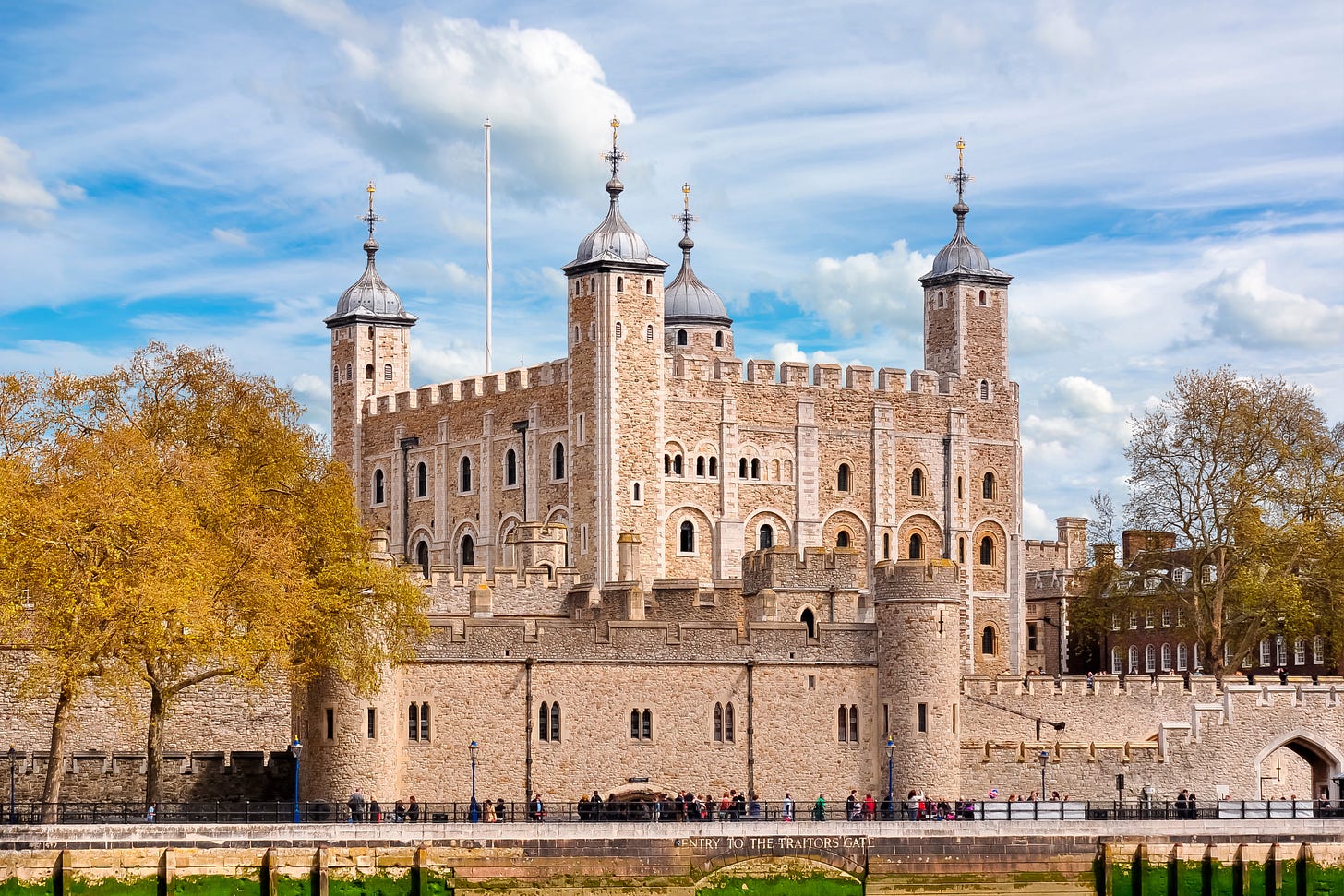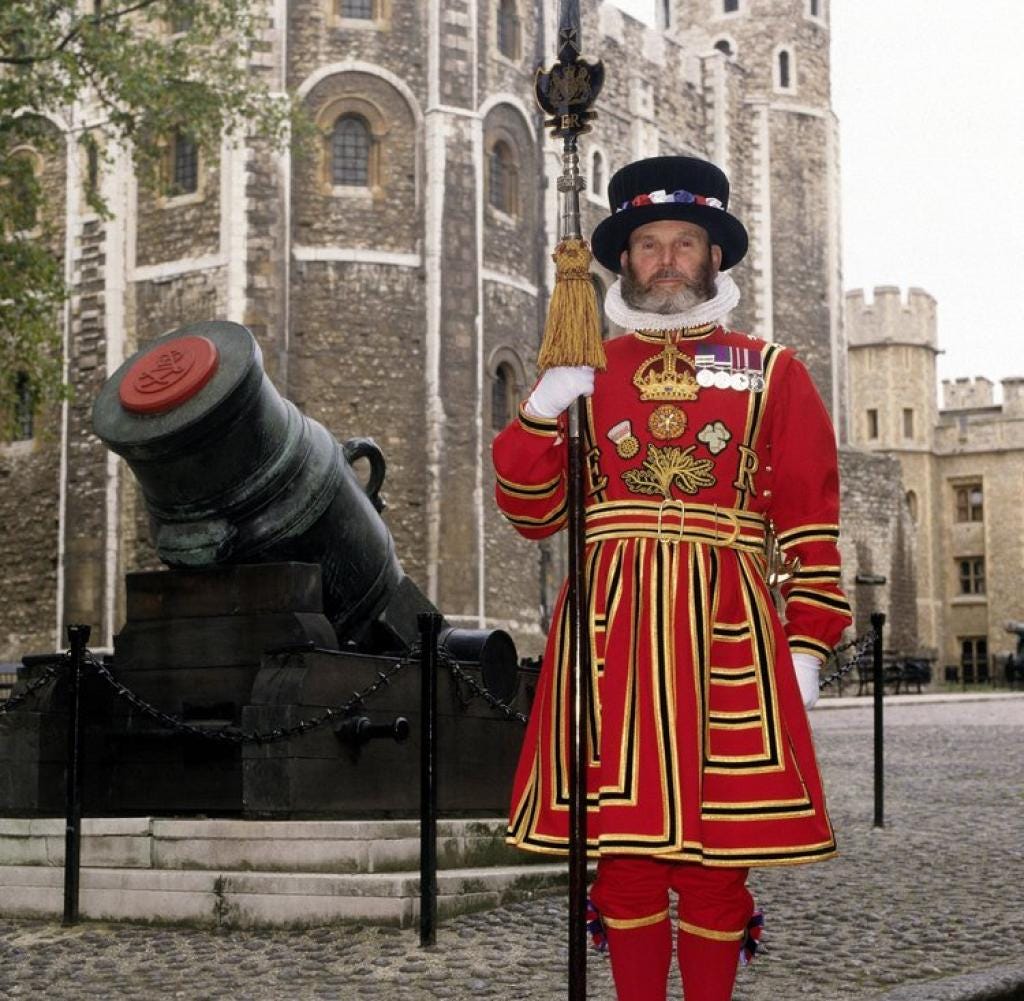The Tower of London: A Historic Fortress of Power and Intrigue
Featured in Plan for the Worst by Jodi Taylor
The Tower of London is one of Britain’s most iconic landmarks, rich in history, mystery, and tradition. Located on the north bank of the River Thames, this formidable fortress has stood for nearly a thousand years, serving as a royal palace, prison, treasury, armoury, and execution site. Today, it remains one of the UK’s most visited attractions and a UNESCO World Heritage Site, offering a fascinating insight into England’s past.
Origins and Construction
The Tower of London was founded by William the Conqueror in 1066 following his victory at the Battle of Hastings. To establish his dominance over England, he ordered the construction of a series of castles, with the White Tower—the oldest part of the complex—being built around 1078. This massive stone keep, designed to impress and intimidate, was a revolutionary structure for its time, symbolising Norman rule and military strength.
Over the centuries, various monarchs expanded the fortress. King Henry III (1216–1272) and King Edward I (1272–1307) added defensive walls, towers, and moats, transforming the site into an imposing medieval stronghold. The Tower played a crucial role in securing the city of London and was frequently used as a royal residence during times of unrest.
The Tower as a Royal Palace and Armoury
Despite its later association with imprisonment, the Tower was originally a grand royal residence. Monarchs, including King Henry III and King Edward I, used it as a luxurious palace, complete with banqueting halls and chapels. The medieval royal apartments can still be explored today, offering a glimpse into how kings and queens once lived within its walls.
From the 14th century onwards, the Tower also became home to the Royal Armouries, where weapons and military supplies were stored. This function continued for centuries, with the Tower playing a key role in England’s military history. Some of its vast collections, including medieval suits of armour, remain on display for visitors today.
The Tower as a Prison and Execution Site
By the late medieval period, the Tower gained a reputation as a prison for high-status captives. Over the centuries, many prominent figures were held within its walls, often accused of treason or political crimes.
Famous prisoners included:
Anne Boleyn (1536) – The second wife of Henry VIII, executed on
charges of adultery and treason.
Catherine Howard (1542) – Henry VIII’s fifth wife, also beheaded for
alleged infidelity.
Lady Jane Grey (1554) – The “Nine Days’ Queen”, executed after her
brief and contested reign.
Sir Thomas More (1535) – The former Lord Chancellor, executed for
refusing to accept Henry VIII’s break from the Catholic Church.
The Bloody Tower and Beauchamp Tower still bear the marks of prisoners who carved their names and messages into the stone walls during their imprisonment.
The Tower Green, within the inner grounds, was the site of private royal executions, including those of Anne Boleyn and Lady Jane Grey. Public executions, however, often took place on Tower Hill, just outside the fortress, drawing large crowds.
The Tower and the Crown Jewels
One of the Tower’s most famous attractions today is the Crown Jewels, a dazzling collection of royal regalia used in coronation ceremonies. These treasures, housed in the Jewel House, include:
St Edward’s Crown – Used during the coronation of British monarchs.
The Imperial State Crown – Worn by the monarch at the State Opening of
Parliament.
The Sovereign’s Sceptre with Cross – Containing the Cullinan I diamond,
the largest clear cut diamond in the world.
The Crown Jewels have been kept at the Tower since the 17th century, following an attempted theft by the notorious Colonel Thomas Blood in 1671. Today, they are protected by the Yeoman Warders (Beefeaters) and remain one of the most visited exhibits in the UK.
The Tower’s Unique Residents: The Ravens
A longstanding legend states that if the ravens ever leave the Tower, the kingdom will fall. This superstition dates back to the time of Charles II (1660–1685), who insisted that the birds be protected.
Today, a group of at least six ravens is kept at the Tower, carefully cared for by the Ravenmaster. Each raven has a name and personality, and they have become an integral part of the Tower’s identity, entertaining visitors with their intelligence and mischief.
The Yeoman Warders (Beefeaters)
The Yeoman Warders, commonly known as Beefeaters, have guarded the Tower for centuries. Originally, they were elite royal bodyguards, but today, they serve as ceremonial guardians and tour guides. Dressed in distinctive red and gold uniforms, they provide historical tours, sharing stories of the Tower’s dramatic past.
To become a Yeoman Warder, one must have served at least 22 years in the British Armed Forces and hold the Long Service and Good Conduct Medal. Their presence adds to the Tower’s historic atmosphere, keeping traditions alive for modern visitors.
The Tower in the Modern Era
While no longer used as a royal residence or prison, the Tower of London remains a working historic site. It has served various roles over the centuries, including housing a royal zoo (until 1835) and being used as a secure fortress during both World War I and World War II.
Today, it is managed by Historic Royal Palaces and continues to attract millions of visitors each year. Events such as ceremonial gun salutes, reenactments, and guided tours ensure that the Tower’s history is kept alive.
Discover what happened to the team from St Mary’s at the Tower of London in Plan for the Worst by Jodi Taylor.
We hope you have enjoyed this History Briefing - please CLICK HERE to read more background history from The Chronicles of St Mary’s series by Jodi Taylor.
Have you discovered The Official Reading Companion and History Briefings for The Chronicles of St Mary’s series by Jodi Taylor?
If you've ever found yourself wondering who did what, when, and where in Jodi Taylor’s brilliant Chronicles of St Mary’s series — this is the companion guide you’ve been waiting for.
This guide is a must-have for both dedicated fans and curious newcomers. It contains synopses of every book and short story, detailed floor plans of St Mary’s Institute for Historical Research, History Briefings, chronological jump lists, character information, and more.
Whether you’re brushing up on the timeline or want to immerse yourself further in the chaos and charm of St Mary’s, this guide is your ultimate companion.
CLICK HERE to learn more.





